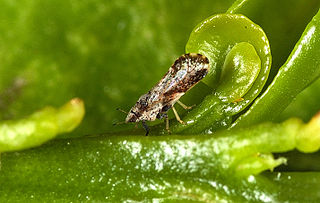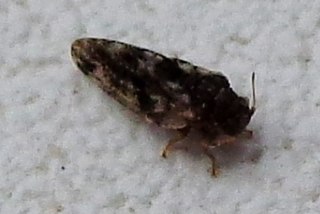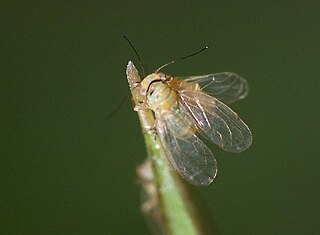
Psyllidae, the jumping plant lice or psyllids, are a family of small plant-feeding insects that tend to be very host-specific, i.e. each plant-louse species only feeds on one plant species (monophagous) or feeds on a few closely related plants (oligophagous). Together with aphids, phylloxerans, scale insects and whiteflies, they form the group called Sternorrhyncha, which is considered to be the most "primitive" group within the true bugs (Hemiptera). They have traditionally been considered a single family, Psyllidae, but recent classifications divide the group into a total of seven families; the present restricted definition still includes more than 70 genera in the Psyllidae. Psyllid fossils have been found from the Early Permian before the flowering plants evolved. The explosive diversification of the flowering plants in the Cretaceous was paralleled by a massive diversification of associated insects, and many of the morphological and metabolic characters that the flowering plants exhibit may have evolved as defenses against herbivorous insects.

Psylloidea is a superfamily of true bugs, including the jumping plant lice and others which have recently been classified as distinct families. Though the group first appeared during the Early Jurassic, modern members of the group do not appear until the Eocene, and Mesozoic members of the order are usually assigned to the possibly paraphyletic family Liadopsyllidae.
Eurotica is a genus of jumping plant lice in the subfamily Aphalarinae and tribe Xenaphalarini, erected by Loginova in 1962.

Triozidae is one of seven families collectively referred to as jumping plant lice. They have traditionally been considered part of a single family, Psyllidae, but recent classifications divide the group into a total of seven families; most of the genera remain in the Psyllidae, but Triozidae is the second-largest family in the group, containing 27 genera, and a number of pest species.

Diaphorina is an Old World genus of sap-sucking hemipteran bugs in the family, Liviidae. It includes an important pest of citrus: the Asian citrus psyllid, D. citri.

Aphalaridae is a bug family in the superfamily Psylloidea.

Homotomidae is a family of small phloem-feeding bugs in the superfamily Psylloidea, or jumping plantlice.
Phacopteronidae is a bug family in the superfamily Psylloidea.

Aphalarini is a tribe of jumping plant lice (psyllid) in the subfamily Aphalarinae, first described by Franz Löw in 1879.

Trioza is a genus of sap-sucking bugs in the family Triozidae.
Calinda muiscas is a species of jumping plant lice of the genus Calinda in the family of Triozidae. The species was first described in 1997 by Olivares and Burckhardt.

Psyllinae is a subfamily of plant-parasitic hemipterans in the family Psyllidae. There are about 12 genera and at least 40 described species in Psyllinae.

Heteropsylla is a genus of plant-parasitic hemipterans in the family Psyllidae. There are more than 40 described species in Heteropsylla.
Platycorypha nigrivirga is an insect.

Liviidae is a family of plant-parasitic hemipterans in the order Hemiptera. There are more than 20 genera and 370 described species in Liviidae.

Trioza adventicia, commonly known as the syzygium leaf psyllid, lillypilly psyllid, or eugenia psyllid, is a sap-sucking hemipteran bug in the family Triozidae which creates galls on the leaves of Syzygium paniculatum. This species is native to eastern Australia and has been introduced into California, southern Australia, and New Zealand.
Spanioneura is a genus of sap-sucking insects belonging to the order Hemiptera. There are five described species in Spanioneura.
Calinda is a genus of true bugs belonging to the family Triozidae.
Liadopsyllidae is an extinct family of hemipteran insects belonging to Psylloidea ranging from the Early Jurassic to Upper Cretaceous. The family was named by Andrey Vasilyevich Martynov in 1926. They are the earliest known members of Psylloidea, with modern members of the group not known until the Paleogene, as such, they have been suggested to be a paraphyletic assemblage ancestral to modern psylloids. The family Malmopsyllidae has been subsumed into this family, but is considered distinct by some authors.









